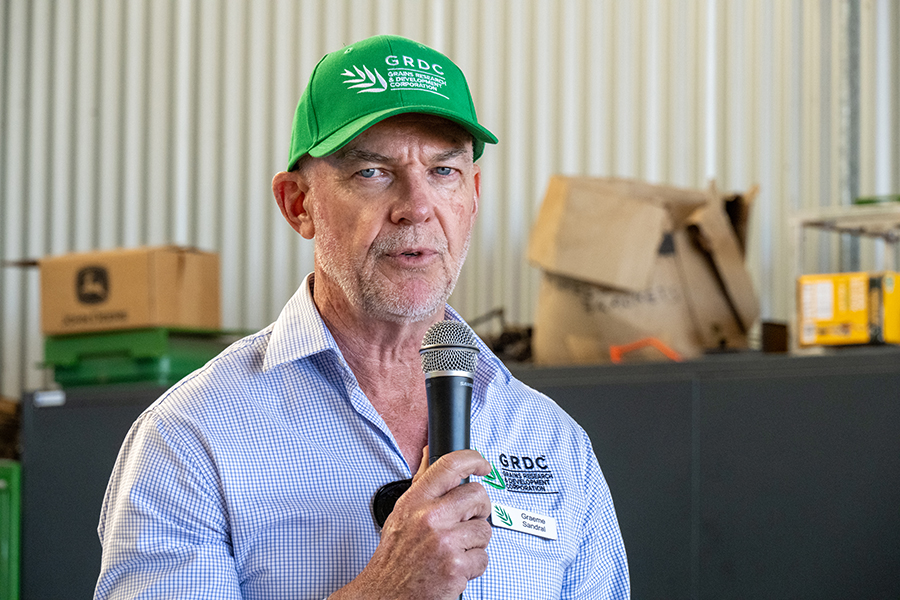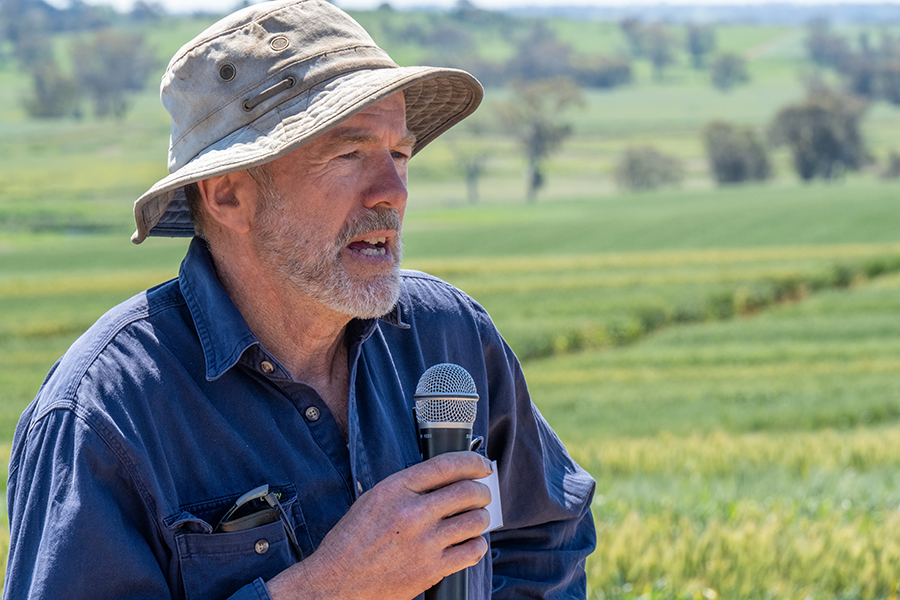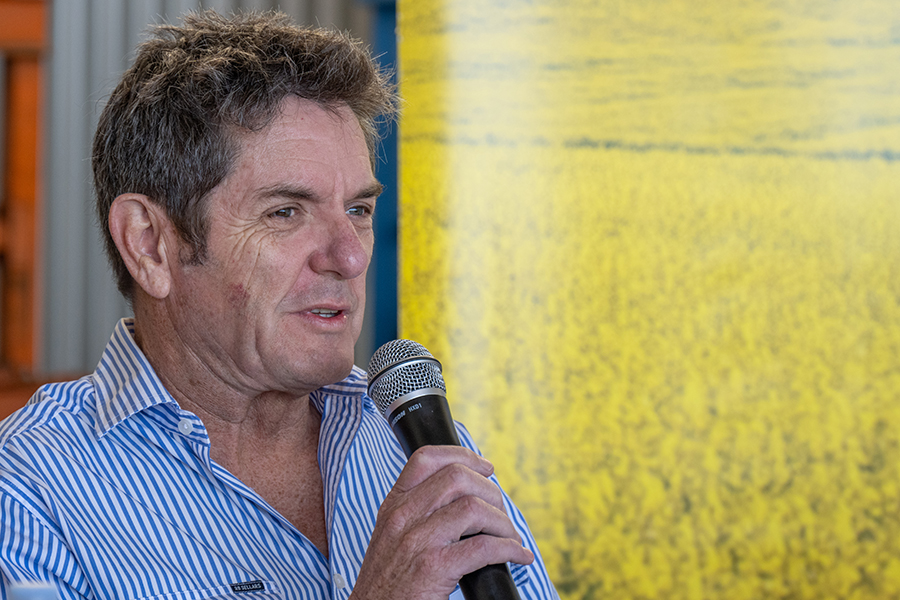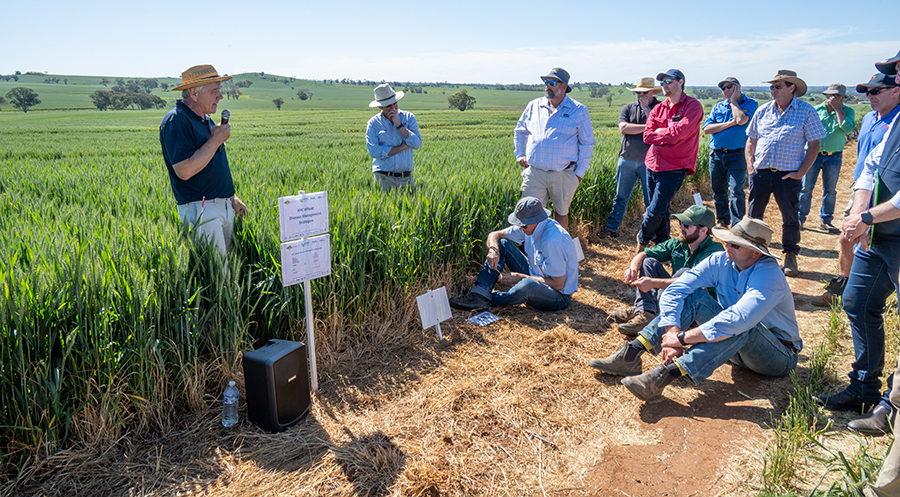Growers, researchers and advisers who visited the New South Wales GRDC Hyper Yielding Crops (HYC) trials in the past three years have learned plenty about crop nutrition, variety choice, fungicide use and increasing grain yields to new highs.
In a welcome address to field day attendees near Wallendbeen in October, GRDC grower relations manager - north Graeme Sandral said the HYC research team wanted to challenge the accepted water-use efficiencies achieved by grain growers in high-rainfall areas.
“The research team has demonstrated in the paddock that much higher yields can be obtained,” he said.
“Their small plot trials have identified the key management levers we must focus on to reach new grain yield frontiers.”

GRDC grower relations manager (north) Graeme Sandral. Photo: Nicole Baxter
Response to manure
Rohan Brill from Brill Ag noted that in 2021, after a lucerne phase, the trials showed a canola grain yield response to three tonnes per hectare of manure but no response to urea.
“In 2021, we saw canola yields of 6.5t/ha with Pioneer® 44Y95CL,” Mr Brill said.
“We generally found the spring canola varieties were more consistently higher yielding than the winter canola varieties, although the winter types have a great fit for mixed farmers.”
He said manure responses were found across all GRDC HYC sites on mainland Australia in 2021.
“At Wallendbeen, where 3t/ha chicken manure was applied with 225 kilograms/ha nitrogen, there was a grain yield response of 0.6t/ha in 2021 and 0.5t/ha in 2022.
“There was a further grain yield increase of 0.4t/ha in 2022 where the mineral fertiliser equivalent of 3t/ha of chicken manure was applied as inorganic fertiliser using monoammonium phosphate (MAP), urea and potassium sulfate.”
Mr Sandral said further research with GRDC investment was underway, led by Grain Orana Alliance and the University of Queensland, to better understand the yield responses to manure versus fertiliser.
“After measuring the yield responses to manure additions, we want to compare balanced supplies of inorganic nutrients to organic nutrients, and think more work is needed to unravel and explain the differences,” he said.
“We don’t have enough animal manure to put across all farms, but we hope to improve our understanding of what manure provides and whether we can replicate that with inorganic fertiliser.
“We also hope to determine whether it is micronutrients, the slow release of nitrogen, added phosphorus nutrition, better protection from nitrogen loss pathways, or something else unexpected.”
Yields in 2022

Rohan Brill from Brill Ag is testing different canola varieties’ responses to high and low nutrient inputs at Wallendbeen, New South Wales. Photo: Nicole Baxter
Mr Brill said canola yields were lower in 2022 at Wallendbeen compared with 2021, at about 4.5t/ha, because of increased cloud cover and very wet soil conditions.
In these environments, Mr Sandral said that rather than water limiting the grain yield potential, the combination of light and temperature measured as the photothermal quotient could cap yields in some years.
“When fertilising canola, having all nitrogen applied by the bud stage is ideal,” Mr Brill said. “This is because urea generally needs three to four weeks to become available to plants. Nitrogen is especially required during the critical period when the grain number is set.”
The critical period is about one week after the start of flowering and lasts for three to four weeks. Grain number generally drives yield.
Mr Brill said research had shown that for every tonne of target yield, canola needs 80kg of nitrogen supplied from the soil and/or fertiliser.
“For example, growing a 5t/ha crop requires about 400kg/ha of nitrogen. How much is supplied will determine the economic response,” he said.
“Canola in high-yielding environments seems more nitrogen efficient and based on nitrogen off-take.”
In the past, nitrogen off-take for canola has been estimated at 40kg/ha of nitrogen, Mr Sandral said.
However, Mr Brill said HYC trials had shown an average nitrogen off-take of about 30kg of nitrogen per tonne of grain.
Accordingly, he said the nitrogen requirement may be less per tonne of grain yield target than previously thought. However, this needs to be quantified with more research.
“In 2023, biomass cuts of some canola varieties in the high-input treatments indicated 7.4t/ha yields for 45Y28 RR, 6.5t/ha in 45Y95 CL and 5.4t/ha in HyTTec® Trifecta," Mr Brill said.
“In the low-input treatments, we had 5.3t/ha for 45Y28 RR, 5.1t/ha for 45Y95 CL and 4.3t/ha for HyTTec® Trifecta. Further biomass cuts at the end of the critical period and again at maturity will help relate grain yield to growth during the critical seed set phase.”
Due to dry weather in September, he estimated the 2023 canola crops would yield 4.0 to 4.5t/ha.
In terms of plant populations, he said there had been no response from 15 plants per square metre to 75 plants/m2 across nearly all the HYC sites over the past three years.
“We do see more lodging with higher plant populations. For 15 to 75 plants/m2, we’re looking at sowing about 1.2kg/ha up to about 6kg/ha.”
At Wallendbeen, he said it was relatively easy to get canola established. Establishment rates could be lower in other environments, requiring higher sowing rates to achieve the same outcomes.
Nitrogen and canola
Field Applied Research (FAR) Australia research manager Tom Price said one of the lessons he learned was how nutrition was the biggest lever that could be pulled to increase canola yields.
“By contrast, with wheat, the biggest lever we can pull to increase yield is improving our disease management,” he said.
“At Wallendbeen, we’ve been able to grow more than 11t/ha of wheat in two out of the three years, and that has come from plots where we’ve applied less than 200kg/ha of nitrogen.”
Mr Sandral said the nitrogen off-take from 11t/ha is about 220kg/ha. If the soil nitrogen uptake efficiency was 50 per cent, 440kg/ha of soil nitrogen was required, of which 240kg/ha of nitrogen was mineralised from the soil.
Fertile farming system

Charlie Baldry of Baldry and Sons hosted the GRDC Hyper Yielding Crops trials on his farm near Wallendbeen, New South Wales. Photo: Nicole Baxter
Trial host Charlie Baldry from Baldry and Sons runs a farming system based on six years of pasture and six years of crops in a continuous canola/wheat sequence.
The average annual rainfall at the Baldry family’s farm is about 680 millimetres.
Their pastures comprise a Phalaris-cocksfoot-lucerne-subclover mix. They plant a Prairie grass-chicory-subclover mix on wet soils. Less than 20 per cent is sown to lucerne-clover.
“It’s taught me that we need to lift our game a bit as growers,” Charlie said. “This country and climate have a higher potential than we’ve achieved in the past.”
Through the GRDC HYC research on his family’s farm, he has learned that more nitrogen can be added to canola in favourable seasons to take advantage of higher yields.
The family’s stubbles are grazed after harvest, and the wheat stubbles are burnt just before sowing.
Wheat disease
Charlie said he had learned to be more proactive with fungicide management rather than reacting to symptoms.
“Although we have seen some high disease pressure in the past few years, we’ve been able to keep on top of it by applying fungicide before we see symptoms,” he said.
About one-third of the Baldry family’s wheat is Anapurna, one-third is LRPB Raider and one-third is LRPB Mustang wheat undersown with pasture.
Charlie said the red feed wheat Anapurna had helped to increase grain yields on the farm.
“We weren’t growing any red feed wheat until I saw the yields coming out of these trials,” he said. “And I thought we needed to start growing Anapurna.”
The family’s sheep graze Anapurna wheat for two months before the crops are locked up for harvest. In 2022, grain yields of some crops averaged seven to 8t/ha.
“That’s been a big plus for us because sheep are a very important part of our enterprise. Our paddocks come out of the pasture phase with 200kg/ha or more of nitrogen. We don’t apply nitrogen to our crops in the first year out of pasture, but we do apply it in the second and subsequent years.”
The family now does a lot more soil testing and, with the help of the Delta Agribusiness Precision Agriculture team, has all paddocks zoned according to fertility.
“We spend a lot of money on crops in terms of lime because the last thing we want to see is an issue with soil acidity at depth.”
Charlie generally applies 50 to 100kg/ha of nitrogen at sowing. The remainder of the nitrogen is applied at growth stage (GS) 32 for wheat and budding for canola. He treats his MAP with flutriafol and applies wheat fungicides at GS32 and flag leaf emergence.
In most years, all canola receives a fungicide spray at 20 per cent bloom.
Lodging a risk

Broden Holland farms between Young and Grenfell, NSW. Photo: Nicole Baxter
Broden Holland, who farms between Young and Grenfell, NSW, said one lesson he learned from the HYC site at Wallendbeen was that growing a big crop with canola is relatively easy if you focused on the key management levers.
“It’s easier to feed canola and give the crop what it needs,” Broden said. “Wheat is different because of disease and lodging risks; consequently, you need a different approach.”
In 2022, BigRed wheat sown at 50kg/ha on his family’s farm had patches that yielded up to 10t/ha.
“It’s not all about more nitrogen because where we put 500kg/ha of urea in some strips, the crop lodged and only yielded 7t/ha.”
Disease management

Delta Agribusiness executive director Chris Duff, Young, NSW. Photo: Nicole Baxter
Delta Agribusiness executive director Chris Duff said that in 2020, Septoria tritici blotch became a bigger issue across the district. It had not been an issue for the previous 20 to 25 years.
“Timing is critical with Septoria,” Mr Duff said. “And product choice does make a big difference, with higher-priced products doing a better job.”
Broden said that some of the paddocks on his family’s farm, given lower nitrogen inputs, had more disease on their flag leaves. But crops with higher nitrogen inputs had greener flag leaves.
FAR Australia managing director Nick Poole said something often observed with nitrogen and fungicides was that as nitrogen inputs increased, the crop canopy persisted for longer.
“If the canopy persists for longer in a susceptible variety, there’s another chance for more disease cycling,” he said.
Improved confidence
Mr Duff said that from the growers’ point of view on a regional scale, he had observed that the research had lifted growers’ confidence.
“The information and data have given a next-level layer of confidence to make decisions, particularly to go higher with our nitrogen inputs on canola,” he said.
“Whereas with wheat, it is a more complicated system, and we’re not seeing the same yield gains.”
Another positive outcome of the research, he said, was that the data had proven that feed wheat (as a dual-purpose crop) could be grown in annual rainfall regions of 550mm and above.
“Feed wheat has added another bonus to the current system and has a place on farms with sheep,” he said.
Varieties and disease

Field Applied Research Australia research manager Tom Price. Photo: Nicole Baxter
From a disease-resistance point of view, Mr Price said in 2022 that a breeding line called AGTW005 did not show a yield response to fungicide, indicating it had a high level of resistance to disease.
“In 2022, where no fungicide was applied to Scepter, it yielded under 1t/ha,” he said. “Where one fungicide was sprayed, Scepter yielded an extra 1t/ha. With a full fungicide program, Scepter yielded 6.5t/ha.”
With Anapurna, he said, the 2022 data showed that reducing fungicide use to a single flag leaf spray was possible. All other varieties required four units of fungicide across 2020, 2021 and 2022.
Gradually, over the past decade, Mr Poole said, the Septoria tritici blotch pathogen had developed tolerance (reduced sensitivity) to flutriafol.

Field Applied Research Australia managing director Nick Poole (left) speaking to some of the growers who attended the October GRDC Hyper Yielding Crops field day near Wallendbeen, New South Wales. Photo: Nicole Baxter
“For Septoria, we’re still dependent on foliar sprays to manage the pathogen,” he said.
“If our seasons become drier, generally, we’ll see the Septoria pressure reduce because there won’t be the launch pad that 2022 had with high pathogen levels on thick stubbles.”
He said that if crops were sown in May, the risk of yield loss from Septoria reduced.
The 2023 results for all GRDC HYC sites are expected to be analysed and released in early 2024. Keep an eye on faraustralia.com.au/resource for the results.
More information: Rohan Brill, rohan@brillag.com.au; Graeme Sandral, graeme.sandral@grdc.com.au; Tom Price, tom.price@faraustralia.com.au; Charlie Baldry, charlie@baldryandsons.com; Broden Holland, bghwr250@gmail.com; Chris Duff, cduff@deltaag.com.au; Nick Poole, nick.poole@faraustralia.com.au

























































